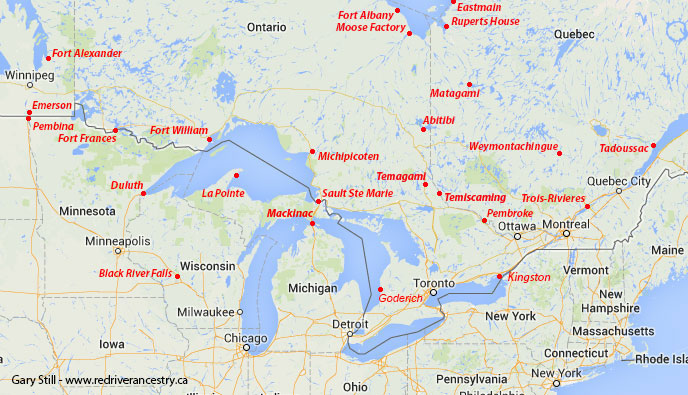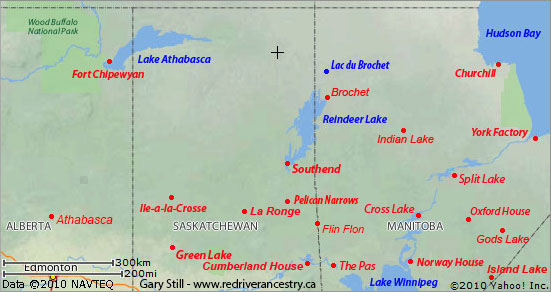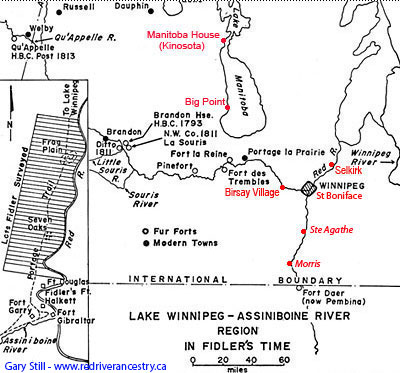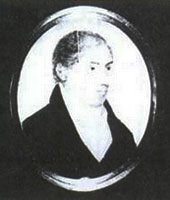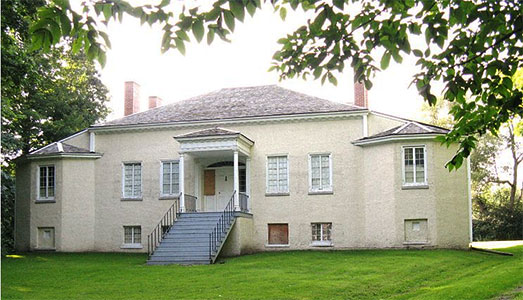JOHN DUNCAN CAMPBELL SR (1773-1835) ELIZABETH McDONALD (1804-1890) (Last Updated: January 27, 2014)
John Duncan CAMPBELL was born on Feb 21, 1773 in New York (Schoharie), son of Magdalena VAN SICE and Alexander CAMPBELL (1734-1800), a United Empire Loyalist who was born in Scotland. ** MORE ABOUT ALEXANDER CAMPBELL
The family was forced to flee the US in 1778. They settled at New Johnstown when Duncan was five years old. New Johnstown (later named Cornwall) was located along the St Lawrence River southwest of Montreal and southeast of Ottawa.
From 1792 to 1797 Duncan’s father (Alex) was a member of the Legislative Assembly (MLA) in Upper Canada (Toronto), representing Dundas county west of Cornwall.
In 1800 Duncan’s father (Alexander CAMPBELL) died in New Johnstown.
Duncan becomes a Partner in the North West Company
In 1803 at the first meeting at Fort Kaminisquia (Fort William) two men who were to play important roles in the NWC were admitted to the partnership, David THOMPSON (1770-1857) and John Duncan CAMPBELL.
In 1804 William McGILLIVRAY (1764-1825) became the Head of the North West Company. JD's younger brothers, Colin CAMPBELL (1787-1853) and Richard CAMPBELL (1790-1812) preceded JD in going west. They were at Fort Dunvegan around 1805-06.
Duncan’s first voyage to the Interior – Ile a la Crosse 1809-1811
For most of his career, JD was in charge of the English River (now Churchill River) district in northern Saskatchewan.
Roll of the Beaver Cliub of Montreal: In 1809 JD CAMPBELL is listed as making his first voyage to the interior. This is the year that Peter FIDLER (1769-1822) arrived with a party of 15 men to re-establish Ile a la Crosse House. Again the NWC began their oppressive tactics. It was around this time that Duncan began a connubial relationship with an Indian or Metis woman named Catherine. ** MORE ABOUT PETER FIDLER
The usual annual routine of ‘overwintering’ NWC partners (Nor’Westers) was to have their voyageurs (canoe men) load their canoes with European trade goods in the east (Montreal or their main supply depot at Fort William) in the late summer, travel the waterways from Lake Superior up to Lake Winnipeg and from there to their remote trading posts in the northwest. The winter was spent trading for furs which they then transported back east along the same routes in the summer for export to European markets.
The spring season of 1810 brought more incidents of fighting, kidnapping of employees, midnight concerts and damage to HBC goods. FIDLER kept a clear record of the actions taken by the Nor'westers. Letters of complaint to J CAMPBELL at the opposing NWC post revealed the situation. John CAMBELL had a bully by the name of Samuel BLACK in his service. FIDLER's men were harassed each time they left the fort. Often BLACK would use a fist to settle any dispute. Through it all, on Jan 27, letters are exchanged by CAMPBELL and FIDLER regarding getting together for dinner. And yet, the spring of 1811 brought more incidents of fighting, kidnapping or employees, midnight concerts and damage to HBC goods. It was with relief that the HBC people saw breakup allow them to leave with their goods to return to York Factory Headquarters. Before leaving, FIDLER and his 2nd-in-command, Robert SUTHERLAND, made their opponent, John Duncan CAMPBELL, responsible for their buildings. Needless to say, hours after their departure in June, their buildings were demolished by fire.
A Scrip Affidavit (filed in 1875) for son Duncan CAMPBELL JR, born in 1810 states his parents as an Indian woman (un-names) and Duncan CAMPBELL SR. Similarly, an 1876 Scrip for daughter Marie (married to William McGILLIS) born 1816 sates her parents as Catherine (half-breed) and Duncan CAMPBELL, a Scotchman.
In 1812 the wintering partners of the NWC numbered 38. Among the names listed: John D. CAMPBELL, John SAYER, Donald McTAVISH, Kenneth MacKENZIE and Charles CHABOILLEZ. JD's little brother, Richard, died at Fort Dunvegan in 1812 (only 22 years old).
The First Selkirk Settlers Arrive at the Forks
In 1812, there was a growing conflict between the two major companies, the HBC and the NWC with the arrival of the first of Lord SELKIRK’s settlers at Red River, led by Miles MACDONELL (1767-1828), the first Governor of Assiniboia. The Nor’Westers saw the colonists as a threat to the fur trade and supply of pemmican. On Jan 8, 1814, anticipating the arrival of yet another large group of settlers and seeking to solve the colony’s food problems once and for all, Miles MACDONELL issued his historic Pemmican Proclamation. The proclamation prohibited the export of provisions of any kind from within the limits of Assiniboia without a special license from the Governor (himself). For two winters the Métis had provisioned the colonists with bison meat, so this severe measure was considered an insult, not only to them but to the NWC.
In July of 1814 the NWC held its annual meeting at Fort William where an indignant William McGILLIVRAY (1798-1804) declared regarding MACDONELL’s actions "It is the first time the Nor'Westers have permitted themselves to be insulted". From that day there would be civil war in the North-West. To meet force with force the NWC later appointed a soldiery of men often referred to as “Captains of the Métis”. Included were: Cuthbert GRANT (1796-1854), Simon FRASER (1776-1862), Angus SHAW (c1765-1832), Nicolas MONTOUR (1790-1846) and Bostonnais PANGMAN (b-c1778).
After Nor’Wester John WILLS (1775-1815) died in the winter of 1915-16, John Duncan CAMPBELL took charge of NWC operations at Fort Gibraltar. The opposing HBC post was called Fort Douglas (named after Thomas DOUGLAS, Lord SELKIRK).
The locations of Fort Douglas and Fort Gibraltar are shown in the inset at the left.
John Duncan CAMPBELL saw the Pemmican Proclamation as an open invitation to bribe the colonists to leave the settlement. If results weren’t achieved in this endeavour, he further believed he was given a free hand to harass the settlers into departing.
On Mar 13, 1815 Cuthbert GRANT (1796-1854) wrote to CAMPBELL that he was game for harassing the settlers, “and never to see any of them again in the colonizing way in Red River ...”
The Seven Oaks Massacre
On May 8, 1816, true to his word, Cuthbert GRANT set out from Fort Qu’Appelle with a troop of 60 Métis horsemen, on an expedition clearly intended to prevent the resurgence of the rival power on the Red River. First they ambushed the HBC boats, under Pierre-Chrysologue PAMBRUN (1793-1841) and James SUTHERLAND (1777-1844), bringing pemmican down the Qu’Appelle. Joined by Alexander Greenfield MACDONELL (1782-1835) and the NWC boats, GRANT then escorted the pemmican down the Assiniboine, and at the Souris River he and his men captured and ransacked the HBC’s Brandon House, commanded by FIDLER. GRANT then proceeded to Red River, and on June 19 The Battle of Seven Oaks occurred with Governor Robert SEMPLE (1777-1816) and twenty of his men killed on Frog Plain. The Metis then took Fort Douglas. ** MORE ABOUT ROBERT SEMPLE in DCBO Lord SELKIRK Arrives at Fort William
On Aug 12, 1816, Lord SELKIRK and his soldiers arrived at Fort William where he arrested all of the NWC Partners who were present, including William McGILLIVRAY.
It seems that John Duncan returned to his activity in Ile a la Crosse and the English River District.
1819
In 1819 the HBC sent John CLARKE (1782-1852) to try his luck in finally getting established at Ile a la Crosse in opposition to the NWC. ** MORE ABOUT JOHN CLARKE in DCBO In June of 1819 HBC Governor William WILLIAMS (1770-1837) launched an offensive against the Nor’Westers in coordination with Captain William MATTHEY and his De Meruron soldiers at Grand Rapids where he was joined by John CLARKE who preceded the Nor’Westers on their return to Lake Winnipeg from Ile a la Crosse by way of the Saskatchewan River. One by one, WILLIAMS arrested unsuspecting Nor’Westers at the bottom of the rapid. The haul included partners John Duncan CAMPBELL, Benjamin FROBISHER, William CONNOLLY, John McDONALD (le Borgne), John Angus SHAW, John George McTAVISH and William McINTOSH as well as a number of their voyageurs. (Bumsteas) ** Lord SELKIRK had forwarded to WILLIAMS various warrants issued by a grand jury in Lower Canada. The Nor’Westers subsequently brought for trial in Lower Canada were released for want of prosecution and legality of the warrants. John Duncan was arrested for his activities in support of the Seven Oaks affair.
Union of the North West Company with the Hudson’s Bay Company
In 1821 the union of the North West Company (NWC) and the Hudson’s Bay Company (HBC) occurred, ending the years of bitter rivalry for dominance of the fur trade in Western Canada. ) George SIMPSON (1786-1860) became the Governor of Rupert’s Land. ** MORE ABOUT GOVERNOR GEORGE SIMPSON
Many former NWC employees were dismissed or retired after the union, including John Duncan CAMPBELL who retired to Montreal. ** Note: It looks like Duncan must have abandoned Catherine and his half-breed children (probably in Red River area, perhaps St Francois Xavier) to begin a new life in Upper Canada. This was not always a malicious act. Native wives and half-breed children did not fare well in the upper society of the east. However, to date, I have not found whether he made any compensations for his native family. Son Duncan Jr. would have been about 11 years old then, daughter Marie about five.
Marriage to Elizabeth McDONALD
Duncan married Elizabeth McDONALD (b. in the 1770's) in 1822 at Montreal, PQ. Elizabeth was the daughter of Nancy (nee SMALL) and John MacDONALD of Garth (1771-1866), a prosperous fur trader.
In 1824 Duncan bought Inverarden House (now a National Historic Site) from his father-in-law, John McDONALD of Garth, a prosperous fur trader.
John Duncan CAMPBELL
Inverarden House National Historic Site (Wikipedia)
On May 6, 1835 the elder John Duncan CAMPBELL died in Cornwall, Upper Canada.
In 1890 Eliza McDONALD-CAMPBELL died at Inverarden.
In 1836 daughter Marie married William McGILLIS in St Francois Xavier, son of Marguerite and Angus McGILLIS (1774-1842).
In 1847 eldest son Duncan Jr. married Widow Nancy (nee HENRY) PRUDEN, daughter of Agathe LETENDRE and William HENRY (1784-1864). ** MORE ABOUT WILLIAM HENRY She was the widow of William PRUDEN who had died in 1844, the son of Nancy (Indian) and John Peter PRUDEN (1778-1868). ** MORE ABOUT WILLIAM PRUDEN
Comments and queries at this link: FORUM DISCUSSING DUNCAN CAMPBELL and his CHILDREN
============================= Family Details =============================
Children by Catherine: ** MORE ABOUT DUNCAN CAMPBELL JR 2. 1816 MARIE CAMPBELL (m. William McGILLIS)
|

